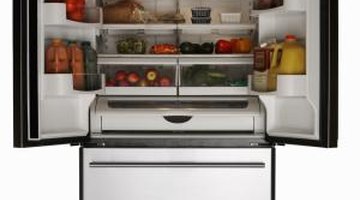Which Gas Is Used in Fridges?
Refrigerant gases are chemical coolants that condense at high pressure but have low evaporation points. Historically, several different gases have been used in refrigerators. Many of these chemicals have been phased out, either because their gases had the potential to emit ozone-depleting chlorine, or because the substances contained components that could contribute to global warming. The earliest coolants were also less than ideal because they were hydrocarbons derived from non-sustainable crude oil.
Early Gases

The earliest chemical coolants, used for refrigerators before the 1930s, were hydrocarbons -- propane, isobutane and cyclopentane. In the 1930s, chlorofluorocarbons, or CFCs, appeared on the scene. The brand name for most CFCs was freon, or R22. Hydrofluorocarbon gas, or HFC, replaced CFC when the latter was discovered to add to ozone layer depletion when accidentally leaked into the atmosphere. Additional names for HFC include tetrafluorethane and HFC-134a. Unfortunately, HFC is also a known contributor to global warming.
Greenfreeze
Greenpeace, an environmental protection organization, is now campaigning against both CFC and HFC and championing a return to hydrocarbon gases. The hydrocarbons are now the coolants of choice in domestic refrigerators produced in Europe, China, Australia, Japan and Latin America. Hydrocarbon fridges are labeled "CFC and HFC free" or R600a refrigerant/coolant. Greenpeace calls its hydrocarbon initiative, "Greenfreeze."
Other Refrigerants
Some older, smaller refrigerators commonly used another chlorinated refrigerant called R-12. This refrigerant was phased out in the 1990s and was replaced by tetrafluoroethane, or R134A. The replacements are referred to by their brand names -- Suva 134aA, HFC-134A and Genetron 134A. Industrial scale refrigeration plants use ammonia, or R-717, which is an efficient, environmentally-friendly coolant. Propane is another coolant that is gaining popularity as a replacement in older systems that originally ran on R44 or freon.
The Future
The ideal gas refrigerant has yet to be developed. Ammonia can be harmful if inhaled and propane has explosive properties. Hydrocarbons depend on the world's ever-decreasing supply of oil, leaked CFC can deplete the earth's ozone layer, and HFC is a contributor to global warming. Currently, environmentalists can only choose the refrigerant that has the lowest negative impact. Until a worry-free coolant is developed, the coolants of choice are hydrocarbons.
References
Writer Bio
Kevin Ann Reinhart, a retired teacher-librarian, has written professionally since 1976. Reinhart first published in "Writers' Undercover" Cambridge Writers Collective II. She has a bachelor's degree in English and religious studies from the University of Waterloo and a librarian specialist certificate from Queen's University and the University of Toronto.
Photo Credits
- Ryan McVay/Photodisc/Getty Images
More Articles



